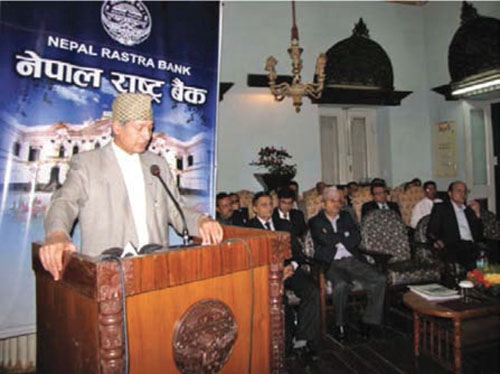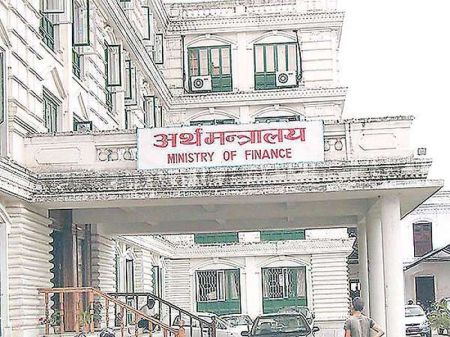.jpg) NIC Asia Bank – Makes History
NIC Asia Bank – Makes History Nepal Industrial and Commercial (NIC) Bank and Bank of Asia Nepal (BoAN) completed their merger process and commenced a joint operation as NIC Asia Bank from June 30. This is the first time two commercial banks have merged in the country’s banking history.
With this merger, NIC Asia Bank Ltd has become one of the top five banks of the country in terms of size of capital, branch network and the like. This merger has brought down the number of commercial banks to 31.
In the merger process, 13 branches of both the banks at the same locations have been amalgamated. Nine branches from outside Kathmandu Valley and four within the valley are consolidated. The newly merged bank is planning to open new branches in other areas within a year to make up for the number of branches reduced by this amalgamation.
The merged entity has a paid-up capital of Rs 2.31 billion; however, its reserves will make the actual capital size exactly double of the figure. Its deposit size is Rs 39 billion and credit Rs 33 billion, making it the fifth largest commercial bank of the country. After the merger, the existing shareholders of BoAN will get additional shares of the newly merged NIC Asia Bank on a 2:1 ratio.
Governor of Nepal Rastra Bank, Dr Yuba Raj Khatiwada said that more responsibilities have been added to the newly merged bank. He also asked the bank to increase investment in the manufacturing sector which will be beneficial for the financial stability of banks in the long term.
Sashin Joshi, the CEO of NIC Asia Bank Limited asked for reduction of the corporate tax rate to 20 percent from the existing 30 percent for the next five years for merged banks to encourage further consolidation in the banking industry.
 NB Bank, Civil Bank Shares Dematerialized
NB Bank, Civil Bank Shares Dematerialized Nepal Bangladesh Bank and Civil Bank have got their shares dematerialized on July 16. An agreement for dematerialization was signed between CDS and Clearing CEO Subodh Sharma Sigdel and NB Bank CEO Gyanendra Prasad Dhungana and Civil Bank CEO Kishore Maharjan. Following the agreement, NB Bank’s 20.11 million unit shares and Civil Bank’s 20 million unit shares have been dematerialized.
Meanwhile, CDSC has also accepted NMB Capital as a depository participant on July 16. The CDSC now has 9 depository participants.
IPO of BFIs within 3 Yrs of Operation
Banks and financial institutions (BFIs) can go for initial public offering (IPO) within 3 years of operation as per new Unified Directives, 2013 of Nepal Rastra Bank. Earlier the time limit was of 2 years. After this, the only remaining IPO of Century Commercial Bank can go for IPO till the end of mid-March 2014. The bank started its operation from March 10, 2011. Similarly, 10 development banks who were in pipeline for IPO got additional time after this new provision.
New Directives to Banks on Dealing with Cheques
Nepal Rastra Bank has issued new directives regarding dishonoured cheques. As per the new directives, the bank should inform the drawer if the cheque presented to the bank is dishonoured due to insufficient balance in the account of the drawer. If the cheque so dishonoured is presented to the bank again and the balance is still insufficient to honour it, the bank should inform the Credit Information Bureau (CIB) to blacklist the drawer. The central bank has made these provisions mandatory from July 16. In the same set of directives, the central bank has asked the banks to honour only account payee cheques if the payments are to be made to a firm, a company, or an office. Similarly, the new directive has stated that if the amount written in number and words differ, the amount written in words is to be recognized.
 Microfinance and Agro Friendly Monetary Policy
Microfinance and Agro Friendly Monetary Policy Nepal Rastra Bank (NRB) has brought out a monetary policy that is specially friendly to strengthening micro-finance and agriculture sectors.
In the policy announced on July 21, NRB has cut the Cash Reserve Ratio (CRR) by one percent. With the introduction of new monetary policy, the category ‘A’ financial institution has to maintain CRR at 5 per cent, while category ‘B’ and category ‘C’ institutions have to maintain it at 4.5 per cent and 4 per cent, respectively.
Likewise, the policy has fixed the Statutory Liquidity Ratio (SLR) of 12 percent, 9 percent and 8 percent for category A, B and C financial institutions, respectively which is one per cent decrease compared to the previous provision.
The central bank has also reduced the refinancing rate for agriculture, hydro-power and others productive sectors to 5 per cent from earlier 6 percent.
The central bank failed to address demands put forth by the Nepal Bankers’ Association (NBA). It has provisioned that the commercial bank has to have a total of 20 percent of outstanding loans in ‘productive’ sector including at least 12 percent in agriculture and energy sector by end the of May 15, 2015. The association has demanded to relax the provision saying the compulsory provision can create unnecessary pressure to the banks.
Similarly, bankers’ association had also asked the central bank to relax the provision of Credit-Deposit Ratio (CDR) and increase it to 85 percent. But the central bank did not change the provision of CDR from 80 percent.
Similarly, Nepal Rastra Bank did not bring any provision to relax real estate lending.
NRB says the new monetary policy will help to attain 5.5 per cent economic growth rate as targeted by the government budget for FY 2013- 14 and restrict the inflation to 8 per cent in the fiscal year.





















